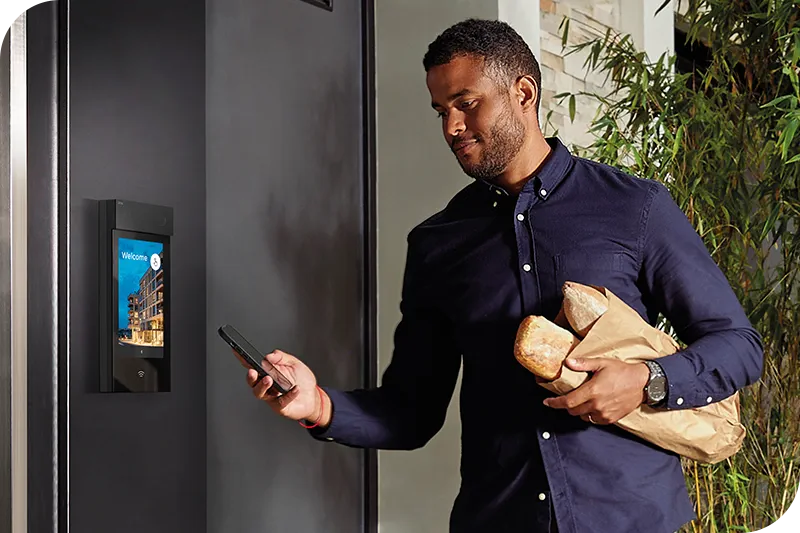The Ultimate Guide to Mobile Access Control
 Camilla Ashdown, 23. 02. 2023 | 10 min read
Camilla Ashdown, 23. 02. 2023 | 10 min read
Learn all about modern mobile access control: how it works, why people want it, and why you should consider it in your next project.

Interested in 2N Mobile Access? Learn all about WaveKey and what it can do for you.
It’s hard to remember a time before mobile phones existed: they’ve replaced everything we need to organise, streamline, and enjoy our lives - from calculators to cameras, wallets to calendars… everything you can think of is now in your pocket, just a touch away. But have you stopped to think about your mobile phone replacing your keys, too?
Believe it or not, this is the direction the access control market is heading, and rapidly, too. Mobile access control is a fast-emerging new technology that will totally replace the access control of yesterday with more convenient yet equally secure credentials.
What is mobile access control?
Before mobile access control, people entered secured buildings using varying access credentials. These credentials can be physical (such as an RFID card you tap onto a reader) or nonphysical (such as a PIN code entered on a keypad) and verify that the person trying to enter is authorised to do so.
Mobile access replaces these physical credentials with the user’s mobile phone. The phone acts the same way an RFID card would (i.e. verifying the resident or worker’s identity) but comes with many benefits that you should consider when thinking about your access control.
How does mobile access control work?
Mobile credentials are granted to users by building managers and are used to grant access to a building or specific area. Usually, these credentials exist as virtual ‘keys’ within apps. But how does the phone open the door?
There are three ways the access control device connects to mobile phones:
1. WiFi
In Wifi-based Systems, both the intercom/access reader plus the mobile phones connect to the same wireless network. The access device then verifies the tenant’s credentials before signalling the door lock to open. As basically all buildings have WiFi – and so this seems a logical option – however, it has its faults. WiFi networks can be unreliable – and no one wants to be locked out of a building when the WiFi goes down. Also, this method can be vulnerable to cybersecurity threats and hackers.
2. Near field communication (NFC)
Near-field communication (NFC) technology connects a phone to the reader via proximity to it. Although it’s not widely known, chances are you’ve used NFC before – its most common use is contactless payment transactions.
However, there is a disadvantage to NFC - it, by nature, requires you to be very close to the access control reader to work (the usual range is a mere few inches). This can mean delays in the door opening since the user has to wait to be in range before the devices start communicating.
3. Bluetooth
Bluetooth Low Energy (BLE) technology is our pick of the bunch. It eliminates the need to manually pair devices as the connection is automatically established from a distance, which can be up to 10 metres depending on the installation and the phone being used.
When a mobile device with access credentials comes close to a Bluetooth IP intercom or access reader, the access device picks up the signal and then the door can be unlocked.
The technology behind mobile credentials is not the only thing that opens the door – users must also complete an action (for example touching a reader with their hand or elbow, or even simply waving their hand) on the access device that will open the door.
A flexible mobile access technology should offer multiple access modes for great convenience – 2N WaveKey, for example, offers no less than 4.
What are the benefits of mobile access control?
1. Security
By eliminating physical credentials and using a cloud-based mobile access system, you remove the risk of misused and misplaced cards or keys. Mistakes happen – but, as phones are such a large part of people’s lives, they’re far less likely to fall into the wrong hands or be left on a bus!
2. Costs
Also related to the loss of physical credentials is the expense of replacing them. By using mobile phones, you no longer need to issue expensive (and environmentally unfriendly) RFID cards or keys.
In residential developments (and some commercial, too) you can even eliminate the cost of front desk management at unsocial hours – users can access their homes at any time of night with complete security if they have their phone.
Mobile credentials are also often much cheaper to distribute, too – some companies even ensure they’re totally free! This offsets the higher costs of Bluetooth-enabled access devices.
3. Convenience for users
As mentioned before, it’s easier for users to always remember to bring their phone (something they’d already bring with them anyway) than it is to remember an RFID card or key. But mobile access is also convenient in other ways – if you’re using Bluetooth access, the user often doesn’t even need to take their phone out of their bag or pocket to open the door (great for when they have their hands full!)
In projects such as gated communities, traditional access methods can require long waits to verify access via car – but in the case of mobile door access control systems, users can be granted access via their phones in a matter of seconds.
One of the best advantages of residential projects is the modernity that mobile access brings: particularly in premium, modern developments where cutting-edge technology can be a major selling-point. This doesn’t mean that mobile access control is limited to only newbuilds: IP technology can also be brought to retrofit projects, too.
4. Convenience for installers & building managers
Convenience is not limited to the users – installers and building managers can benefit, too. Mainly by the remote nature of mobile credentials – they’re easy to distribute and revoke from anywhere in the world.
In the case of mixed-use buildings, mobile credentials can be easily managed to grant access to certain areas (much better than manually programming RFID cards).
Are there any disadvantages to mobile access control?
There can be if you don’t choose the right provider or the right technology: let us show you how 2N Wavekey solves common problems with mobile access…
Speed of access
If you don’t use the correct technology for access it can cause problems, as we mentioned above.
Luckily, WaveKey uses the best of all – Bluetooth – and opens the door in 0.3 seconds, so you won’t have any problems using it in a busy office environment. The secret lies in its unique pre-authentication system of up to 8 mobile phones within the reader’s range.
IP Intercoms or readers picking up the wrong credentials
Often, users or installers are concerned about the access device misreading mobile credentials – for example, how does the IP intercom know that the person at the door is the person allowed access, and it’s not someone simply passing nearby?
Thanks to adaptive algorithms and RSSi signal trend analysis, when you use Wavekey, the reader knows whether the user is approaching the reader or moving away from it. A phone within range but not directly approaching the door will never open it by accident.
Security concerns
Methods such as Wi-Fi can be vulnerable to security threats – in fact, Bluetooth can also be at risk. With Wavekey, Bluetooth communication is fully protected in 2N’s own secure channel. We use AES-128 and RSA-1024 encryption keys making it essentially impossible to eavesdrop and misuse mobile credentials.
What else should you consider when choosing a mobile access control system?
When choosing a mobile access control system, it's important to consider some other factors:
1. Compatibility with existing systems: If you already have an door access control system in place, it's important to choose a mobile solution that is compatible with your existing hardware and software. This will minimize the cost and hassle of upgrading or replacing existing systems. 2N build all devices on open protocols, and partner with over 300 companies to offer limitless integration possibilities.
2. Ease of use: A mobile access control system should be easy to use, with a user-friendly interface and intuitive navigation. This will help ensure that users can quickly and easily manage their access credentials and control access to a building or area. The 2N® Access Commander system allows for quick and intuitive building access management – allowing installers to delegate everyday management to users without problems.
3. Scalability: As an organization grows, the access control system needs to be able to scale with it. Choose a mobile solution that can be easily expanded to accommodate more users and locations as needed.
4. Cost: The cost of a mobile access control system can vary widely depending on the features and functionality it offers. It's important to choose a solution that provides the features and functionality you need while staying within your budget.
Once you have chosen a mobile access control system, there are a few steps you can take to ensure its success:
1. Train users: Ensure that all users are trained on how to use the mobile access control system, including how to download and use the mobile app and how to manage their access credentials. They also need a simple app to use - 2N® Mobile Key, for example, is very intuitive and will allow users to access buildings without difficulty.
2. Set up access groups: Use a platform like 2N® Access Commander to allow users to set up access groups to control who has access to specific areas, such as a particular floor or department. This will help you easily manage and track who has access to what areas, and make it easier to grant or revoke access as needed.
3. Regularly review and update access: Regularly review and update access permissions to ensure that users have the right level of access to the areas they need to access. This will help prevent unauthorized access and ensure that the system remains secure.
4. Monitor usage: Monitor usage of the mobile access control system to ensure that it is being used as intended and to identify any potential security issues.
To conclude
Be sure you’re keeping up with market demands by using mobile access control – it will soon become the standard for door access control systems. There are many things to consider when building the system – but most important is to choose a supplier that prioritises reliability, speed, and security. What’s more, it’s always helpful to choose a company that ensures end users and those who will manage the system can manage credentials effectively.